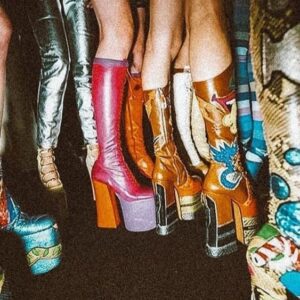Disco Style: Fashion, Glamour & Identity
If disco had a heartbeat, it pulsed not only through music, but through mirrors, sequins, silk, and sweat. Disco style was not an accessory to the movement. It was the movement. It made statements without words. It dressed bodies in courage, fantasy, and rebellion. The club was the stage, and everyone who stepped onto the dancefloor became part of a living, breathing performance.
Emerging from a decade of political unrest and urban hardship, the 1970s demanded release. And disco fashion delivered it. Gone were the dull, muted tones of utility. In their place came electric color, metallic fabrics, and silhouettes that shimmered like the music they moved to. It was glam, but it was also deeply personal. For many, it was the first time they could truly choose how to be seen, and how to define themselves.
Disco fashion blurred the boundaries between genders and generations. Men wore makeup. Women wore tuxedos. And everyone wore platform shoes. The idea was not to blend in, but to blaze forward. Fluidity replaced formality. Clothing became a tool of transformation. You could be a Wall Street worker by day and a Studio 54 goddess by night – and no one would blink. Disco style said: there is power in change.
It also democratized glamour. While high fashion contributed to the movement – Halston, Diane von Furstenberg, Stephen Burrows – many of the most iconic looks came from thrift stores, handmade pieces, and fearless experimentation. Creativity outranked couture. The goal wasn’t perfection, it was expression. A sparkle here, a slit there, and suddenly, you were reborn in strobe light and shadow.

Ankle-Breakers or Heels to Die For, 1977 / Source: wchbuy.shop
Few places embodied this aesthetic revolution more than Studio 54. Inside those velvet ropes, fashion reached surreal heights. Nudity mingled with feathered capes. Sequined bodysuits danced next to business suits. Bianca Jagger entered on a white horse. It wasn’t about style rules, it was about style revelations. Studio 54 wasn’t merely a nightclub. It was a runway, a temple, a social experiment in fabric and form.
Yet even beyond the elite clubs of New York, disco style thrived in local communities. Roller rinks in the Midwest, discos in Rio, back-alley clubs in Rome – all had their own flavor of sparkle and defiance. What united them was the universal desire to be seen and celebrated. Disco made that possible. Whether in a handmade lamé dress or vintage bell-bottoms, people found their light, and wore it boldly.
Fashion also played a central role in the emotional architecture of disco. A plunging neckline wasn’t just sensual, it was liberating. A shiny catsuit wasn’t just trendy, it was armor. In a world that demanded conformity, disco said: wear what you feel. Clothes were chosen for how they moved, reflected, and provoked. And when the beat dropped, it wasn’t just the bass that hit, it was the collective unleashing of beauty, confidence, and joy.
Today, the echoes of disco style are everywhere. From runway collections that recycle glitter and gold, to the mainstream embrace of gender-fluid fashion, disco’s aesthetic legacy endures. More than a trend, it was a cultural rupture, a visual manifestation of freedom. And when we wear that shimmer today, we’re not just evoking the past. We’re continuing a movement where beauty, expression, and identity still dance together under a shared mirrorball.
CONTINUE EXPLORING THE CULTURAL INFLUENCE AND LEGACY OF DISCO:
• Clubbing Culture & Studio 54
• The Art of the DJ: Turntables as Cultural Icons
• Disco in Film and Television: From “Thank God It’s Friday” to “Pose”
• From New York to the World: Disco’s Global Cultural Spread
• Flyers, Posters and Lightshows: The Visual Language of Disco
SOUND REFLECTIONS:
A few key tracks that not only defined the disco sound but also embodied its fashion-forward spirit, where music and style danced together under the mirrorball:
“Get Down Tonight” – KC & The Sunshine Band (1975)
“Le Freak” – CHIC (1978)
“I Love the Nightlife (Disco ‘Round)” – Alicia Bridges (1978)
“Boogie Oogie Oogie” – A Taste of Honey (1978)
“Fashion” – David Bowie (1980)
Full Spotify playlist: TOP 500 ESSENTIAL DISCO CLASSICS (1972-1979)
